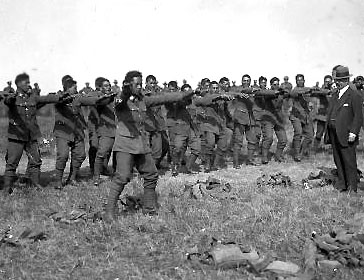|
NEW ZEALAND FOLK * SONG |
Te
Ope Tuatahi |
|---|
|
This was the recruiting song of the First Maori Contingent
in World
War One. They served in Egypt, Gallipoli, France and Belgium.
2 - wiwi - Wiwi are clumps of rushes. There is a story of Te Rauparaha getting his warriors to wrap their cloaks around wiwi at a distance from an enemy pa before a dawn attack, to deceive the pa's guards. 3 - Wiwi - Frenchmen. When the Maoris went to France, they heard the French saying "Oui! Oui!" Yes! Yes! all the time. 4 - Kau atu has been translated as in vain, or remembering. But kau mai means to slowly come into sight, like a boat over the horizon, so kau atu must be the opposite, slowly fade away. Te Hokowhitu a TuThey landed at Anzac Cove on 3 July 1915 and soon proved their worth both as hard working and cunning engineers, as well as doughty fighters. They were soon committed to the fighting as a contingent and from a strength of 476 officers and men were reduced to 60 by August when they were rested on the Greek island of Lemnos. On 20 February 1916, the remnants of the original Maori Contingent was combined with with Maori reinforcements and men of the Otago Mounted Rifles, plus 125 Niue Islanders and 45 Rarotongan, to form The New Zealand Pioneer Battalion. The Pioneer Battalion reached France on 9 April 1916 and served on the Western Front for the rest of the war. They were an engineering force consisting of two Maori companies and two pakeha companies. The purpose of the battalion was to build roads, erect barbed wire entanglements and dig trenches, from which derived the name 'Diggers'. They also took part in raids and battles.
They were the only New Zealand battalion to return home as a complete unit, and when they reached New Zealand in March 1919 they received a rapturous welcome at cities, towns and maraes. 2,227
Maori and 458 Pacific Islanders served with the Pioneer
Battalion.
This
image is from the Great
War Primary Documents Archive
2nd-Lieut Henare Mokena KOHERE 1880.
Born on the East Cape at Te Araroa, where Apirana Ngata
had also been born, 6 years previously. Grandson of Ngati
Porou chief Mokena Kohere. 14 September 1916. Henare was wounded while taking part in one of these raids during the battle of the Somme. His conduct was fitting for a leader of mana. As he lay on a stretcher in his dugout, he appeared comfortable and happy. In one hand he held a lighted cigarette; the other had been smashed by a shell. He expected to die and paid his small debts and trifling mess accounts. Peter Buck, a major in the battalion, visited him, asking 'Kei te pehea koe, Kohere?' How are you? 'Ka nui te kino' Things are very bad, Kohere replied. He died of his wounds two days later. Full biography at DNZB Cowan's 1926 translation
Other Maori songs of the overseas warsPokarekare Ana: popular with Maori solders in 1915-17 preparing to go to WWI. Hoea Ra Te Waka Nei: a heart-breaking cry for financial support for the men in the trenches in France in 1917. E Pari Ra: 1918 tangi for Maori solders lost in battle during WWI. Karangatia
Rä: sung in 1919 to the returning men of the Maori
Battalion after WWI. E te Hokowhitu-a-Tü: a 1943 song remembering the Maori Battalion who were away fighting in North Africa and Italy. Tama Ngäkau Märie: a graveside hymn sung many, many times by men of the 28th Maori Battalion. Tomo mai (Hoki mai) e tama ma: composed in Ruatoria in 1946 to welcome home their soldiers of the 28th Maori Battalion.
Rolling Wheels:written by members of the Maori Battalion as they rolled across Nth Africa, and added to, as they fought their way up Italy. Blue Smoke (Kohu Auahi): written during WWII and internationally popular in 1948. Published
on web 1 April 2005, Kohere biography added 10 May 2005
|
|||||||||||||||||||


